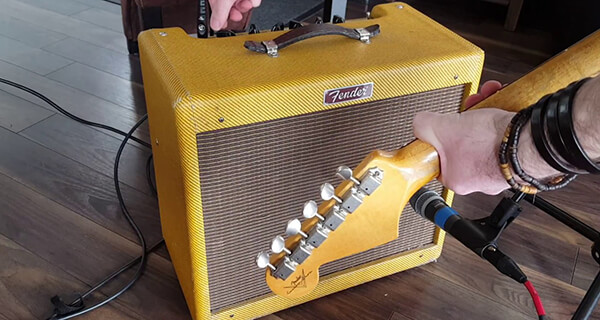Fender Blues Junior Vs Pro Junior [Difference & Which is Better]
When it comes to iconic tube amplifiers, Fender undoubtedly stands as a symbol of excellence in the world of music. Two popular choices among guitarists seeking that classic Fender tone are the Fender Blues Junior vs Pro Junior amplifiers. In this guide, we’ll dissect the nuances of these two amplifiers, exploring their differences and ultimately helping you decide which one reigns supreme in terms of performance.

# Table of Contents =>
Comparison Table:
| Features – | Fender Blues Junior | Fender Pro Junior |
|---|---|---|
| Amplifier Type | Tube (Valve) | Tube (Valve) |
| Wattage | 15 Watts | 15 Watts |
| Speaker Size | 12-inch | 10-inch |
| Channels | 1 (Clean and Fat switch) | 1 (Clean) |
| Controls | Volume, Treble, Bass, Middle | Volume, Tone |
| Tubes | 3 x 12AX7, 2 x EL84 | 2 x 12AX7, 2 x EL84 |
| Reverb | Built-in Spring Reverb | No Reverb |
| Effects Loop | Yes | No |
| Cabinet Material | Particleboard | Solid Pine |
| Weight | Approx. 31 lbs (14 kg) | Approx. 20 lbs (9 kg) |
| Footswitch Compatibility | Yes | No |
| Speaker Output | External Speaker Output | External Speaker Output |
| Price Range (approx.) | $$ (Moderate) | $ (Budget-Friendly) |
| Recommended Use | Gigging, Studio, Home | Practice, Studio, Home |
Fender Blues Junior: The Classic Powerhouse –
The Fender Blues Junior has long been a go-to option for guitarists across genres. It’s renowned for its warm, bluesy tones and its ability to deliver sweet, saturated overdrive. Here’s a closer look at its features and performance:

1. Wattage and Volume:
The Blues Junior proudly delivers 15 watts of power, a modest figure compared to the high-powered amplifiers on the market, yet entirely sufficient for igniting club gigs and studio sessions. Its solitary 12-inch speaker possesses the ability to saturate a room with a luxuriously resonant audio presence. Furthermore, the amp’s remarkable volume prowess ensures a clean, uncluttered sound canvas even under significant pressure, smoothly transitioning into delightful breakup when pushed.
2. Versatility:
One of the Blues Junior’s strengths is its versatility. With its three-band EQ and a “Fat” switch, you can dial in a wide range of tones, from sparkling cleans to gritty blues and even classic rock crunch.
3. Reverb:
The onboard spring reverb is lush and organic, adding a beautiful dimension to your sound. Whether you’re playing clean or with overdrive, the reverb on the Blues Junior enhances your playing experience.
Fender Pro Junior: The Compact Dynamo –
The Fender Pro Junior, on the other hand, is a compact powerhouse designed for simplicity and raw tone. Let’s explore its unique characteristics:

1. Wattage and Volume:
With only 15 watts of power, the Pro Junior may seem identical to the Blues Junior on paper, but it has a distinct personality. It excels at delivering gritty, overdriven tones at lower volumes, making it an ideal choice for home practice and smaller venues.
2. Simplicity:
The Pro Junior adheres to a straightforward design philosophy, featuring only two controls—volume and tone. This minimalist approach encourages a laser-like focus on your playing technique, rendering it an exceptional choice for purists who relish a straightforward, plug-and-play experience.
3. Portability:
This amp’s small size and lightweight design make it incredibly portable. It’s the perfect grab-and-go option for gigging musicians who value convenience without compromising on tone.
Choosing the Right Amplifier for You –
Now that we’ve dissected the Blues Junior and Pro Junior, the question remains: which one is better for your needs? The answer depends on your playing style, preferences, and intended use:
Choose the Fender Blues Junior if:
- You crave versatility and want to explore a wide range of tones.
- You require an amp that can handle different musical genres.
- You prioritize lush reverb for a more atmospheric sound.
Choose the Fender Pro Junior if:
- You love the simplicity of plug-and-play operation.
- You prefer to crank your amp for that natural overdrive without excessive volume.
- Portability is a key factor for your gigging needs.
Conclusion:
In the showdown between the Fender Blues Junior vs Pro Junior, there’s no clear winner only different strokes for different folks. Both amplifiers have their strengths and cater to distinct preferences. The Blues Junior shines with its versatility and lush reverb, while the Pro Junior excels in simplicity and portability.
Ultimately, your choice should align with your playing style and specific requirements. No matter which Fender amplifier you select, you can rest assured that you’re tapping into decades of Fender’s craftsmanship and a legacy of delivering that timeless, classic tone that has defined countless music genres. So, go ahead, plug in, and let your Fender amp take your music to new heights.
FAQs –
Q. What is the difference between Pro Junior and Blues Junior?
Answer: The primary differences between the Fender Pro Junior and Blues Junior lie in their design and intended use. The Blues Junior is known for its versatility, featuring a broader tonal range with a three-band EQ and a “Fat” switch.
In contrast, the Pro Junior opts for simplicity with only volume and tone controls, making it ideal for those who prefer a more straightforward, vintage-inspired experience. Additionally, the Blues Junior often includes reverb, which the Pro Junior lacks. Consider your playing style and tonal preferences when choosing between the two.
Q. Who uses Fender Pro Junior?
Answer: The Fender Pro Junior is favored by musicians who appreciate raw, unadulterated tube amp tones and a no-frills approach to amplification. It’s a popular choice among blues, rock, and garage rock guitarists who value its simplicity and ability to achieve natural overdrive at lower volumes.
Its compact size and portability also make it a go-to option for gigging musicians looking for a convenient yet powerful amplifier.
Q. Is Fender Blues Jr too loud for home?
Answer: The Fender Blues Junior, with its 15-watt power output, can be considered loud for home use, especially if you’re in a shared living space or have close neighbors. However, it’s worth noting that the Blues Junior has a volume control that allows you to adjust the output to lower levels, making it suitable for practicing at home without disturbing others.
You can also invest in an attenuator or use an amp modeling solution to achieve those classic Fender tones at lower volumes while maintaining the amplifier’s character.
Last Updated on October 13, 2023 by Perry Garner


